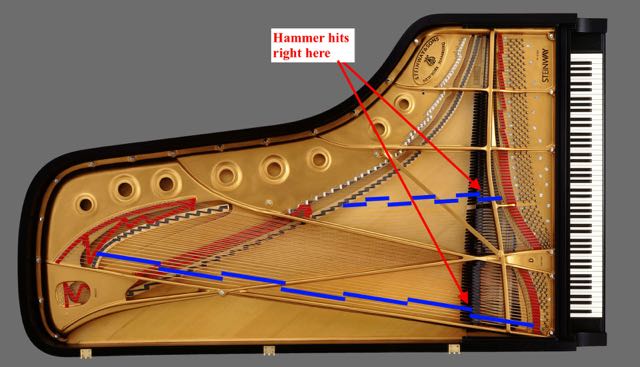Thank you Toshiaki-san, that is a very kind description! And you've saved me from trying to figure out what the heck I'm doing. Ha!
Now for my long silly thoughts...
Excuse me while I put on my amateur scientist?s hat. We all understand the principle of the vibrating string. The combination of tension and length dictate the pitch of the fundamental note. There are also several overtones which speak with the fundamental (I think they?re called ?partials? when they are part of the tone) plus some mechanical noise like fret rattle which together makes up our overall sound.
I believe ? because the neck pu is closer to the center of the string it ?hears? more of the fundamental. The bridge pu nearer the termination of the string ?hears? more of the overtones or shorter vibrations. I think that generally explains why our two pickups have different tonal character, just because of the physical location in relation to the string. Make sense?
Now about this overtone series, which we can also play as harmonics (a finger resting on the string above the 12th fret divides the string into 2 equal parts and sounds the pitch one octave above the fundamental).
The overtone series continues with smaller and smaller equal divisions of the string. Split into 3 equal parts creates the next overtone pitch which happens to be an octave and a 5th above the fundamental. 3rd in the series, 4 equal parts, sounds 2 octaves above the fundamental. Etc.
The next few start to get a little squirrelly. The pitches produced are not all in line with the ?equal tempered scale? which we are used to hearing (in most Western Hemisphere music).
The worst offender is when the string is divided into 7 equal parts (the harmonic roughly above the 3rd fret of our fingerboards). The pitch produced is a very flat 7th to the fundamental and pretty painful if heard as part of a chord for any length of time. (Just ask Mica about the time she could ONLY hear that ugly overtone as she was testing instruments!)
Now the good stuff! (Finally). What?s the easiest way to prevent or limit the amount of that particular partial in the sound? That would be to initiate the vibration right on that ?node? so that the string has little chance of dividing into 7 parts. This is not a new idea, check this out:

I learned that from my dad who was a piano technician as well as a bassist. The best sounding grand pianos purposely strike the string right on that node so as to limit the amount of ugly 7th in the sound. This is almost impossible to do in a small upright piano and that?s why the lower strings often have a gnarly sound.
Now, what does this have to do with this thread? Well, one of the nodes of that overtone happens to be just on the bridge side of the neck pu. If you were to want the least amount of that clashing overtone in with the fundamental you would pluck the note right there! That could probably be considered the sweet spot for fundamental and overtones.
Of course, that sweet spot moves as you move up the neck and shorten the string. If you played a note on the 12th fret, the node would be 1/2 way from the spot I describe above to the bridge, etc.
So in conclusion. A-hem. This probably has NOTHING to do with the question you asked - but I believe I do generally seek this sweet spot when playing. That said, lately my right hand seems to be lurking closer to the fingerboard so I must be reaching for a deeper sound and this entire lengthy story is MOOT. But maybe interesting, I hope.
Best to all,
Jimmy J